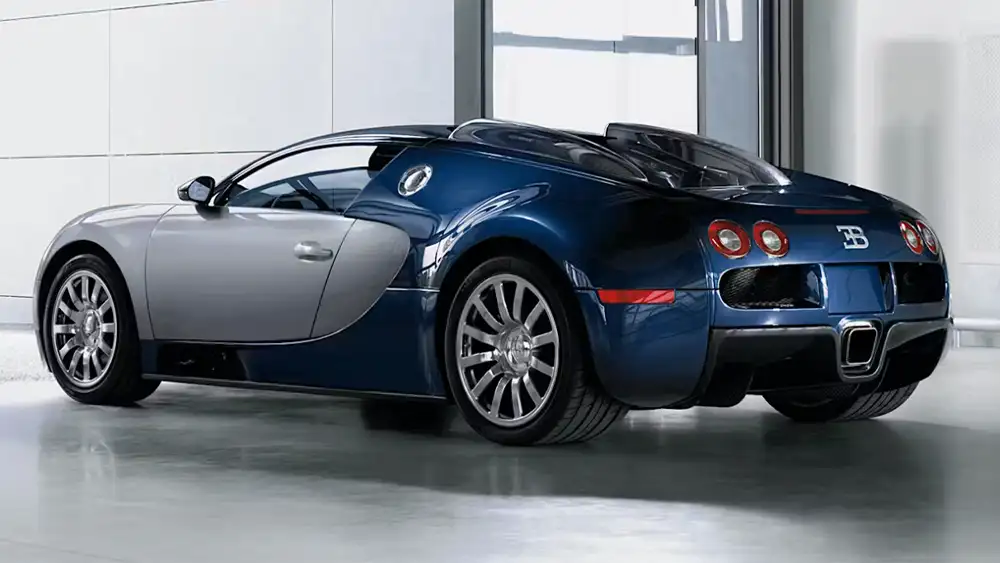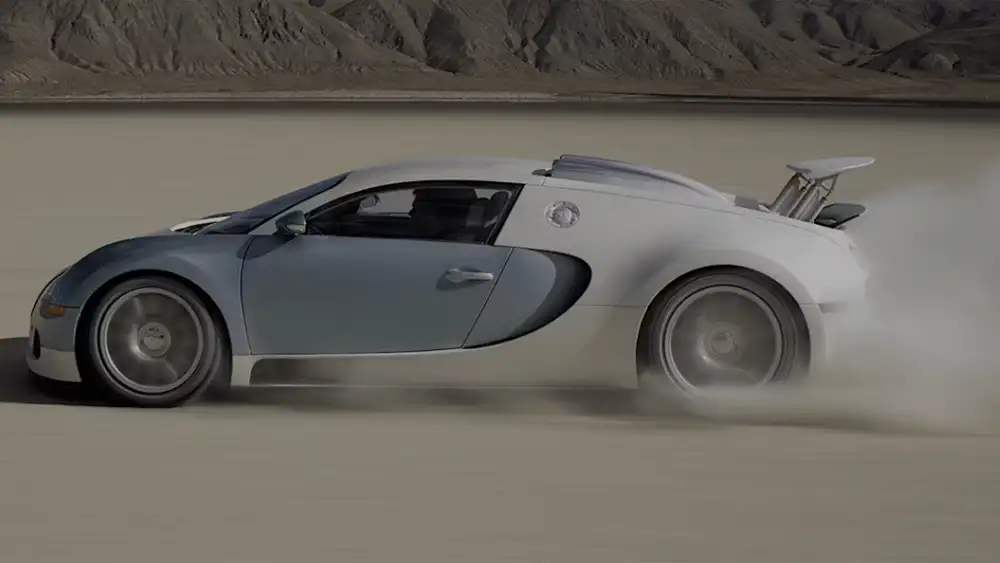Bugatti Veyron – 1000HP That Rewrote the Rulebook

Say the word Vitesse (French word for speed) out loud when you see a Veyron and it makes a beat more sense. The Bugatti Veyron arrived in 2005 and it felt like watching someone build a cathedral out of pistons. Loud, heavy, over the top and somehow refined. It demanded to be noticed, and it changed what the world expected from a hypercar. The Veyron was more than a fast toy. It was a technical manifesto. It showed us how far engineering money and ambition could push combustion engines and chassis in a road legal package.
Why the Veyron matters
Before the Veyron, the idea of a one thousand horsepower production car was mostly fantasy. Bugatti, under Volkswagen Group direction and driven by Ferdinand Piëch’s obsession, turned that fantasy into a production reality. The result was an 8.0 liter, quad turbo W16 bolted into a tailored carbon structure that could hit verified speeds well above 250 miles per hour. It was the first modern hypercar that mixed epic top speed with near-luxury comfort, and for that reason it rewrote the rulebook.
Also read: Fastest Luxury Cars
History
If you want to understand the Veyron you have to start with Ferdinand Piëch. He wanted the fastest, most technically ambitious production car on earth and he had the clout to make Volkswagen buy the Bugatti name and give his team the green light. Work on the modern Bugatti project began in earnest after VW’s 1998 acquisition and the 2000 EB 16/4 concept showed the world a clear direction. By 2001 Piëch had confirmed production in Molsheim, France and engineers set about turning sketches into something you could legally drive on public roads. The first customer Veyrons rolled off the line in 2005. How many of these speedsters Bugatti built? Well, a total of 450 Veyrons across all variants before the run ended around 2015.
Veyron Review
1. Design and interior
Look close and the Veyron reads like a blend of sculpture and aerospace, giving us nod to old Bugattis. That wasn’t unfamiliar for Bugatti loyal fans who have seen flowing lines and low-slung profile of 57SC Atlantic and front-end design of the Type 35.
Exterior lines are smooth where needed, with bold vents and a rump built to accept serious downforce. Inside it is indulgent. Leather everywhere, precision metal switchgear, and single piece aluminum center consoles with guilloché trims on many cars. It feels more Bentley than stripped race car. That contradiction is part of the charm.
2. Engine, gearbox and headline performance

At the heart is the W16, eight liters with four turbos. The standard Veyron put out roughly 987 to 1,001 bhp and about 922 lb ft torque. The Super Sport escalated to around 1,184 bhp and more than 1,100 lb ft. The original 16.4 recorded about 253.8 mph at Ehra-Lessien, while the Super Sport claimed runs in the high 260s, to become the fastest production automobile of its time. Power goes to all four wheels through a bespoke seven speed dual clutch gearbox developed specifically for this torque load. It was unprecedented stuff when it arrived.
3. Chassis, aero and stopping power
If you take it as a muscle car with fancy paint, you are wrong. The Veyron uses a carbon-based structure, a sophisticated hydraulic ride system that lowers at speed and an active rear wing that acts as an airbrake. Bugatti fitted huge carbon ceramic disk brakes with multi piston calipers, and Michelin built bespoke tires (typically around 265 mm front and 365 mm rear on bespoke wheels) able to survive the stresses of 250 plus miles per hour. That combination lets the car be surprisingly composed even when you’re doing utterly ridiculous speeds.
4. Veyron Variants and Special editions
Bugatti made a lot of variations including the original Veyron 16.4, the Grand Sport roadster, the Super Sport coupe and the Grand Sport Vitesse roadster. Then there are the coachbuilt pieces and customer specials. Those limited runs are the reason of its high prices, and that’s why you see Veyrons selling for wildly different prices at auction. The same is true for its successor, the Chiron, which spawned even more expensive and rarest variations like the La Voiture Noire, Profilee, Pur Sport, and the L’Ébé.
- Veyron 16.4 (standard) – the baseline coupe.
- Veyron Grand Sport – targa/roadster variant, priced around $1.9 million.
- Veyron 16.4 Super Sport – high performance coupe with a price around $2.4M in many roundups. This is the record-chasing variant.
- Pur Sang (2007) – very limited (5 units), each priced at $2M. Auto publications like Evo and TopGear, document the rare Pur Sang as highly collectible.
- Fbg Par Hermes costed $2.3M.
- Sang Noir, L’Or Blanc, Meo Constantini and Les Legendes series are limited run coachbuilt cars with prices varying from roughly $1.7M to upwards of $2.6M and in some markets showing greater auction premiums.
5. Collectibility and Auction of Veyron
Veyrons turn up at top auction houses and they still pull serious money for rare specs. I have seen an RM Sotheby’s listing for a Veyron Super Sport 300 sold in Monterey for $2,310,000. Also, a recent RM Sotheby’s Munich catalog listed a 2008 Pur Sang (French for “Pure Blood”), numbered ‘1’. RM Sotheby’s and other houses have documented sales in the $1.5M to $3M plus range for well specified examples.
That said, the collectability of this supercar is still very high. There are many celebrities who own a Bugatti Veyron.
Veyron’s Price and The Cost of Ownership
When Veyron came, it was the priciest production car of its time wearing an estimated price tag of $1.24 million dollar. For comparison, the runner-up was the Saleen S7 twin-turbo supercar. Forbes called it the most expensive car in 2005 at $555,000, which is basically half the Veyron’s cost. Ironically, that Veyron is the least expensive Bugatti of this time with prices of the new Bugatti models like the Bolide, Mistral, and Tourbillon starting at over $4 million.
Fluid and major scheduled work: It is a known Bugatti fact that yearly fluid and service routines can total about $25,000 per year if you follow Bugatti’s recommended service intervals. That includes engine fluids, gearbox and diff services.
Tires: bespoke Michelin PAX sets for the Veyron have been quoted around $38,000 to $42,000 per set. Expect to replace them more often if the car sees track work.
Wheels and other wear items: OEM wheel sets and replacements have been discussed by owners at $50,000 (says Motor1) or more when new from the factory. Labor and parts for anything big add up fast. FormaCar says the automaker suggests $120,000 custom wheels.
Insurance: specialty insurance brokers and aggregated data put annual premiums commonly in the tens of thousands. Estimates vary widely but $20,000 to $30,000 per year for a Veyron is a reasonable ballpark in many markets, rising with value and usage.
How the Veyron stacked up versus its era mates
Back then the main talking rivals were the McLaren F1, Ferrari Enzo and early Koenigseggs. McLaren F1 is still admired for its purity, lightness and driver engagement and it set its own top speed benchmarks. Ferrari focused on driver feel and race bred tech. Koenigsegg took a more radical low weight approach. The Veyron’s answer was different. It was heavy, but brutally fast, supremely refined and hyper engineered. In short it solved a different problem than the McLaren or Enzo.
How Veyron holds up today against Modern Hypercars
The recent hypercars like the Bugatti’s Chiron & Tourbillon and Koenigsegg Jesko lift the technical bar again with more power, hybrid tech in some cases, and more refined aero. The Chiron lineage is a direct evolution of the Veyron and pushes power and speed figures even higher. On the other hand, the Tourbillon is built from scratch, offering hybrid power, and a step up in all departments. Still, the Veyron carries a special weight as the car that made a 1,000 hp production hypercar feel acceptable and civilized. It is the origin story for the modern era of hypercars.
Wrapping it up
The Veyron is not the lightest, prettiest or purest hypercar you can buy. It is an idea that became a machine: proof that if you throw enough money and obsessive engineering at a problem you can rewrite what a road car is allowed to do. It still makes people stop and watch, and that alone gives it a place in car history that is secure. If you ever get the chance to sit in one, take it. The rest will make sense later.
FAQs
The French automaker made about 450 in total. It included both coupé and roadster variants.
Well, I believe not. There are newer and faster hypercars available now. Bugatti itself has moved from the Chiron to Tourbillon. For investment point of view, the Chiron is better than the Veyron.
Expect very expensive servicing, pricey tires (around $40K), and specialty insurance ($20-$30K). Annual running costs in the tens of thousands are common, with larger service events costing much more. Budget carefully.

news via inbox
Sign up and never miss out on the latest news and updates at HighStuff



